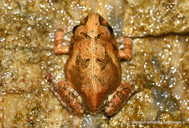|
Sphaerotheca rolandae (Dubois, 1983)
Marbled Sand Frog, Roland's Burrowing Frog | family: Dicroglossidae subfamily: Dicroglossinae genus: Sphaerotheca |
 © 2020 Dayupathi Eranda Nipunika Mandawala (1 of 11) |
|
|
|
Description Distribution and Habitat Country distribution from AmphibiaWeb's database: India, Sri Lanka
Life History, Abundance, Activity, and Special Behaviors Relation to Humans Possible reasons for amphibian decline Prolonged drought Comments
References
Anders, C. (2002). Biologie und Systematik der Amphibien Nepals. Veröffentlichungen aus dem Fuhlrott-Museum, Wuppertal, Germany. Daniel, J. C. (2002). The Book of Indian Reptiles and Amphibians. Bombay National History Society, Delhi. De Silva, A., Molur, S., and Walker, S. (2000). CAMP Report for Amphibians and Reptiles of Sri Lanka. Conservation Breeding Specialist Group, Sri Lanka, Colombo, Sri Lanka. Dutta, S.K. and Manamendra-Arachchi, K. (1996). The Amphibian Fauna of Sri Lanka. Wildlife Heritage Trust of Sri Lanka, Colombo, Sri Lanka. Manamendra-Arachchi, K. (2000). ''Know your frog.'' Sri Lanka Nature, 2(5), 4-16. Schleich, H. H., and Kästle, W. (2002). Amphibians and Reptiles of Nepal. Koeltz Scientific Books, Koenigstein, Germany. Originally submitted by: Peter Janzen (first posted 2005-05-17) Edited by: Tom Devitt, Kellie Whittaker (2007-03-20) Species Account Citation: AmphibiaWeb 2007 Sphaerotheca rolandae: Marbled Sand Frog <https://amphibiaweb.org/species/5206> University of California, Berkeley, CA, USA. Accessed Jun 8, 2025.
Feedback or comments about this page.
Citation: AmphibiaWeb. 2025. <https://amphibiaweb.org> University of California, Berkeley, CA, USA. Accessed 8 Jun 2025. AmphibiaWeb's policy on data use. |


 Map of Life
Map of Life